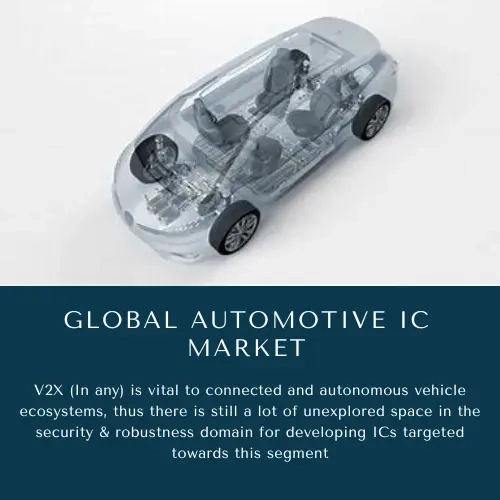
- Get in Touch with Us

Last Updated: Apr 25, 2025 | Study Period: 2024-2030
The global automotive IC (Integrated Circuit) market is witnessing robust growth due to the escalating demand for electronic control systems applications such as engine/powertrain management, multimedia entertainment-related car features, advanced safety solutions including airbags and collision-avoidance detection systems, convenience electronics in dashboard displays which are based on touchscreens/voice command operation capabilities among others. Automotive ICs are automotive-grade semiconductor components focused on specific functions in-vehicle electronics, including powertrain management, safety systems, and information and communication technology (IT) for auto interfacing security devices over the network.
The key automotive IC categories range from microcontrollers (MCUs) to digital signal processors (DSPs), and application-specific integrated circuits (ASICs), all optimized for performance, power efficiency, and functional safety requirements. For example, engine management ICs control the timing of fuel injection and ignition sequences to enhance engine performance - i.e., increase power output or achieve low emission levels with high specific torque per liter -, emissions (output quality), and reliability. Engine Management helps automotive giants make their vehicles run at greater efficiency.

While technological trends in automotive IC design are leaning towards higher processing power, memory capacity as well as increased levels of integration to support the ever-growing complexity of vehicle electronics.These innovations permit real-time data analytics, sensor fusion, and AI-enhanced algorithms that improve vehicle safety, and efficiency whilst augmenting user experience using various driving scenarios.
The automotive IC market is also driven by vehicle electrification, semi-automated driving features (ADAS), and connectivity that are fueling demand for high-performance semiconductor solutions to support sensor networks as well as in-car networking protocols. With automotive OEMs and tier-1 suppliers quickly expanding deployment of smart mobility solutions, the market for automotive ICs is set to rapidly grow in the forecast period
Moving forward, additional future semiconductor manufacturing technologies including 5-nanometer (nm) process nodes and beyond are anticipated to bring about automotive IC design innovation that results in higher levels of integration with lower power consumption and improved reliability. The competitive landscape of the automotive IC market has evolved, consisting largely of dynamic technological innovation and strategic partnerships aimed at designing innovative semiconductor solutions defining next-generation automotive electronics as well as mobility platforms.
Automotive ICs, or automotive integrated circuits are a class of highly specialized semiconductor devices manufactured and designed to perform specific functionality under harsh operating conditions found in automobiles. These are key ICs for modern vehicles that provide advanced functions such as engine control, safety systems, infotainment, and vehicle-to-everything (V2X) communication. For starters, engines like those out of the 7th Generation Toyota Corolla (from Aleph Objects) require specialized engine management ICs to control fuel injection timing and ignition sequences precisely for performance, economy, and emissions compliance.
Safety-critical ICs, such as airbag control units and electronic stability control systems, use precise sensor inputs from the environment and require highly reliable decision-making algorithms to improve vehicle safety during crashes and hazardous driving conditions. The infotainment ICs are utilized for multimedia interfaces, in-car navigation systems, and connectivity solutions which offer enhanced entertainment, communication as well as convenience realized by both drivers and passengers.
With ongoing developments in semiconductor technology, including the use of improved processing architectures and better reliability standards, these markets have not stopped evolving even as they continue to fragment. These technologies have allowed IC manufacturers to meet the extremely tight performance, reliability, and ASIL functional safety levels that automotive OEMs require for products sold around the world.
The ability of automotive ICs to support the next generation of connected, autonomous, and electric vehicles lies ahead. As the automotive industry leans more and more into digital transformation, IC design technologies will be pivotal in enabling innovation around vehicle architecture, performance enhancement as well and overall driving experience to cultivate smarter, safer, and greener mobility solutions reshaping the future of transportation.

The Global Automotive Integrated Circuits (ICs) Market was valued at $XX Billion in 2023 and is projected to reach $XX Billion by 2030, reflecting a compound annual growth rate (CAGR) of XX% from 2024 to 2030.
Integration of Advanced Driver Assistance Systems (ADAS): The integration of ADAS features, such as collision avoidance, lane keeping assist, and adaptive cruise control is stimulating the market for advanced automotive ICs. Such ICs deliver the computation and connectivity required for ADAS capabilities.
AI and Machine Learning in Automotive ICs: The use of automotive embedded microcontrollers (MCU) along with artificial intelligence solutions can be seen as a means to bring more sophistication into emerging vehicle-to-everything applications. So ICs incorporated with AI can consume large volumes of data from sensors and cameras to manage real-time decision-making, which is the path for autonomous driving.
5G Connectivity & V2X Communication: The implementation of 5g technology and vehicle-to-everything (V2X) communication is reshaping the automotive ICs. They are used for high-speed data transmission and low-latency communication making them suitable ICs for connected vehicle applications as well as improving road safety.
Increased Security Features: With cyber threats rising, automotive ICs with stronger security features are increasingly becoming a necessity to guarantee the safety and authenticity of systems in vehicles. Have the data and communication channels protected with such hardware-based security features implemented in these ICs.
NXP Semiconductors S32G2 Vehicle Network: NXP introduced the S32G2 vehicle network processors for ADAS and autonomous driving. These processors are for high performance, safety, and security.
Infineon Technologies - AURIX TC4xx Microcontrollers: Infineon expanded the family of microcontrollers with the introduction of its Aurix TC4xx series for powertrain, safety, and body electronics applications. The ICs offer high-performance processing capability and multiple connectivity features.
Texas Instruments Jacinto 7 Processors: Texas Instruments has introduced its automotive processors designed to provide high-performance infotainment and ADAS capabilities with high processing power beyond solutions required by re-programmability inside a single scalable device. It offers AI / Machine learning capabilities with advanced CPU processors.
Renesas Electronics - RH850/U2B Microcontrollers: These Renesas microcontrollers are designed for high-performance automotive applications using high-speed communication interfaces and enhanced security, which is suitable for connected and autonomous vehicles.
| Sr.N | Topic |
| 1 | Market Segmentation |
| 2 | Scope of the report |
| 3 | Research Methodology |
| 4 | Executive Summary |
| 5 | Average B2B by price |
| 6 | Introduction |
| 7 | Insights from Industry stakeholders |
| 8 | Key Drivers for Global Automotive Integrated Circuits (ICs) market |
| 9 | Disruptive Innovation in the Industry |
| 10 | Overview of Global Automotive Integrated Circuits (ICs) Market |
| 11 | Major impact on Technological advancements |
| 12 | Consumer trends in the industry |
| 13 | Recent technological trends in Global Automotive Integrated Circuits (ICs) Market |
| 14 | SWOT Analysis of Key Market Players |
| 15 | New product development in the past 12 months |
| 16 | Market Size, Dynamics, and Forecast by Geography , 2024-2030 |
| 17 | Market Size, Dynamics, and Forecast by Type , 2024-2030 |
| 18 | Market Size, Dynamics, and Forecast by Vehicle Type , 2024-2030 |
| 19 | Market Size, Dynamics, and Forecast by Application , 2024-2030 |
| 20 | Competitive landscape |
| 21 | Gross margin and average profitability of suppliers |
| 22 | Merger and Acquisition in the past 12 months |
| 23 | Growth strategy of leading players |
| 24 | Market share of vendors, 2023 |
| 25 | Market Company Profiles |
| 26 | Unmet needs and opportunities for new suppliers |
| 27 | Conclusion |